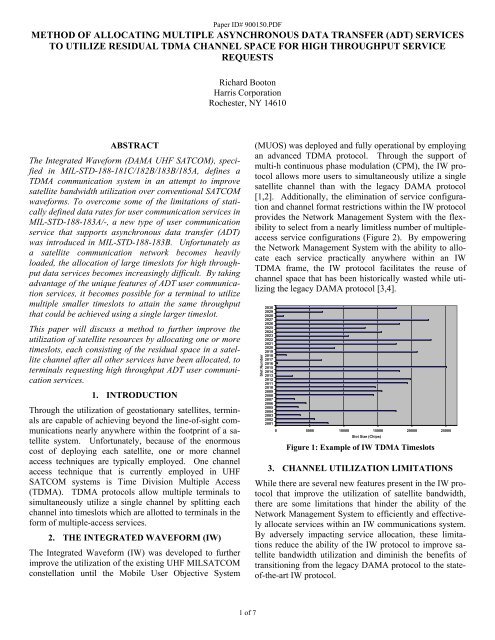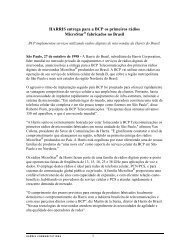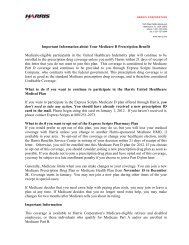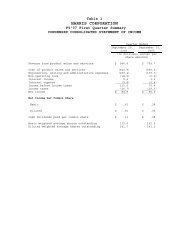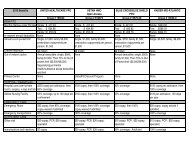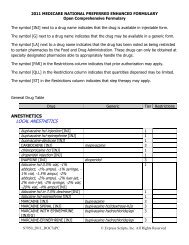METHOD OF ALLOCATING MULTIPLE ASYNCHRONOUS DATA ...
METHOD OF ALLOCATING MULTIPLE ASYNCHRONOUS DATA ...
METHOD OF ALLOCATING MULTIPLE ASYNCHRONOUS DATA ...
You also want an ePaper? Increase the reach of your titles
YUMPU automatically turns print PDFs into web optimized ePapers that Google loves.
Paper ID# 900150.PDF<br />
<strong>METHOD</strong> <strong>OF</strong> <strong>ALLOCATING</strong> <strong>MULTIPLE</strong> <strong>ASYNCHRONOUS</strong> <strong>DATA</strong> TRANSFER (ADT) SERVICES<br />
TO UTILIZE RESIDUAL TDMA CHANNEL SPACE FOR HIGH THROUGHPUT SERVICE<br />
REQUESTS<br />
ABSTRACT<br />
The Integrated Waveform (DAMA UHF SATCOM), specified<br />
in MIL-STD-188-181C/182B/183B/185A, defines a<br />
TDMA communication system in an attempt to improve<br />
satellite bandwidth utilization over conventional SATCOM<br />
waveforms. To overcome some of the limitations of statically<br />
defined data rates for user communication services in<br />
MIL-STD-188-183A/-, a new type of user communication<br />
service that supports asynchronous data transfer (ADT)<br />
was introduced in MIL-STD-188-183B. Unfortunately as<br />
a satellite communication network becomes heavily<br />
loaded, the allocation of large timeslots for high throughput<br />
data services becomes increasingly difficult. By taking<br />
advantage of the unique features of ADT user communication<br />
services, it becomes possible for a terminal to utilize<br />
multiple smaller timeslots to attain the same throughput<br />
that could be achieved using a single larger timeslot.<br />
This paper will discuss a method to further improve the<br />
utilization of satellite resources by allocating one or more<br />
timeslots, each consisting of the residual space in a satellite<br />
channel after all other services have been allocated, to<br />
terminals requesting high throughput ADT user communication<br />
services.<br />
1. INTRODUCTION<br />
Through the utilization of geostationary satellites, terminals<br />
are capable of achieving beyond the line-of-sight communications<br />
nearly anywhere within the footprint of a satellite<br />
system. Unfortunately, because of the enormous<br />
cost of deploying each satellite, one or more channel<br />
access techniques are typically employed. One channel<br />
access technique that is currently employed in UHF<br />
SATCOM systems is Time Division Multiple Access<br />
(TDMA). TDMA protocols allow multiple terminals to<br />
simultaneously utilize a single channel by splitting each<br />
channel into timeslots which are allotted to terminals in the<br />
form of multiple-access services.<br />
2. THE INTEGRATED WAVEFORM (IW)<br />
The Integrated Waveform (IW) was developed to further<br />
improve the utilization of the existing UHF MILSATCOM<br />
constellation until the Mobile User Objective System<br />
Richard Booton<br />
Harris Corporation<br />
Rochester, NY 14610<br />
1 of 7<br />
(MUOS) was deployed and fully operational by employing<br />
an advanced TDMA protocol. Through the support of<br />
multi-h continuous phase modulation (CPM), the IW protocol<br />
allows more users to simultaneously utilize a single<br />
satellite channel than with the legacy DAMA protocol<br />
[1,2]. Additionally, the elimination of service configuration<br />
and channel format restrictions within the IW protocol<br />
provides the Network Management System with the flexibility<br />
to select from a nearly limitless number of multipleaccess<br />
service configurations (Figure 2). By empowering<br />
the Network Management System with the ability to allocate<br />
each service practically anywhere within an IW<br />
TDMA frame, the IW protocol facilitates the reuse of<br />
channel space that has been historically wasted while utilizing<br />
the legacy DAMA protocol [3,4].<br />
Slot Number<br />
2030<br />
2029<br />
2028<br />
2027<br />
2026<br />
2025<br />
2024<br />
2023<br />
2022<br />
2021<br />
2020<br />
2019<br />
2018<br />
2017<br />
2016<br />
2015<br />
2014<br />
2013<br />
2012<br />
2011<br />
2010<br />
2009<br />
2008<br />
2007<br />
2006<br />
2005<br />
2004<br />
2003<br />
2002<br />
2001<br />
0 5000 10000 15000 20000 25000<br />
Slot Size (Chips)<br />
Figure 1: Example of IW TDMA Timeslots<br />
3. CHANNEL UTILIZATION LIMITATIONS<br />
While there are several new features present in the IW protocol<br />
that improve the utilization of satellite bandwidth,<br />
there are some limitations that hinder the ability of the<br />
Network Management System to efficiently and effectively<br />
allocate services within an IW communications system.<br />
By adversely impacting service allocation, these limitations<br />
reduce the ability of the IW protocol to improve satellite<br />
bandwidth utilization and diminish the benefits of<br />
transitioning from the legacy DAMA protocol to the stateof-the-art<br />
IW protocol.
Paper ID# 900150.PDF<br />
3.1. CHANNEL FRAGMENTATION allocation of large timeslots is not handled correctly, the<br />
Though the ability to allocate services nearly anywhere<br />
within an IW TDMA frame has the ability to greatly improve<br />
bandwidth utilization, the enhanced flexibility provided<br />
by the IW protocol also has the potential to leave the<br />
channels under the control of the Network Management<br />
Network Management System can effectively reduce the<br />
channel utilization of an IW communications system by<br />
allowing large timeslots to interfere with the efficient and<br />
effective allocation of all services within a given set of<br />
satellite channels.<br />
System fragmented.<br />
While the IW protocol allows the allocation of services<br />
practically anywhere within an IW TDMA frame, the<br />
17<br />
number of valid timeslot locations which are suitable for<br />
16<br />
15<br />
14<br />
fulfilling the needs of a high throughput data request is<br />
severely limited because large slots by definition consume<br />
13<br />
12<br />
11<br />
a significant portion of the TDMA channel in which they<br />
are allocated. Furthermore, the allocation of a large time-<br />
10<br />
9<br />
slot has a tendency to be extremely difficult in a congested<br />
8<br />
system, because the Network Management System is often<br />
7<br />
6<br />
not able to locate enough contiguous channel space to al-<br />
5<br />
4<br />
3<br />
locate a timeslot of sufficient size to fulfill high throughput<br />
data requests. Consequently, the timeslots for high<br />
2<br />
1<br />
0 5000 10000 15000 20000 25000<br />
throughput data service requests are often allocated to an<br />
available empty channel, i.e. one in which no other time-<br />
Time Chip<br />
slots are currently present, and occasionally denied if there<br />
Allocated Timeslots Unallocated Timeslot Space<br />
are no additional channels available. As shown in Figure<br />
Figure 2: Typical Initial Service Allocation<br />
2, when the percentage of large timeslots allocated in response<br />
to high throughput service requests is high enough<br />
such that there is an insufficient number of smaller services<br />
which can be allocated adjacent to the large timeslots,<br />
the communications system becomes highly fragmented<br />
and more channels must be utilized to fulfill a given number<br />
of services requests.<br />
Chanel Number<br />
Similar to a system where objects of diverse sizes are<br />
placed into a finite number of bins, for example a computer<br />
hard drive, a given number of services within an IW<br />
communications system will typically not fit perfectly<br />
within an integral number of channels (Figure 2). Unfortunately,<br />
the impact of this issue reduces the efficiency of<br />
satellite bandwidth utilization proportionally to the level of<br />
fragmentation within the service layout. Additionally, as<br />
every satellite channel in an IW communications system<br />
becomes fragmented, the allocation of services will become<br />
increasingly difficult without the extensive deallocation<br />
and reallocation of services that are already active.<br />
Furthermore the decrease in bandwidth utilization will inevitably<br />
lead to the denial of service requests, due to the<br />
inability of the Network Management System to locate<br />
enough contiguous channel space to allocate timeslots of<br />
sufficient size in order to fulfill every service request.<br />
3.2. LARGE TIMESLOTS<br />
Although the elimination of service configuration and<br />
channel format restrictions within the IW protocol provides<br />
the flexibility to select from a nearly limitless number<br />
of multiple-access service configurations, the allocation<br />
of large 1 timeslots for high throughput data services<br />
can present a surprisingly difficult service allocation problem<br />
for the Network Management System. Furthermore, if<br />
1 Large services are those that consume at least one half of the available<br />
time chips in a given TDMA channel.<br />
2 of 7<br />
Once a large timeslot has been allocated to a particular<br />
TDMA channel, the options available to the residual timeslot<br />
space within the channel in which the large service<br />
was allocated are drastically reduced. In addition to making<br />
the allocation of adjacent services more complex, due<br />
to the reduction in the number of adjacent service options<br />
and the increased difficulty of allocating an adjacent service<br />
that does not have any slot contention, by consuming<br />
such a significant portion of a channel the remaining number<br />
of time chips available for adjacent service is often less<br />
than the minimum timeslot size necessary to fulfill an additional<br />
service request. Unfortunately, the effect of this<br />
issue is that the channel space adjacent to large timeslots is<br />
rarely, if ever, used. Consequently, the IW communications<br />
system ends up in a state where the Network Management<br />
System would have been better off allotting high<br />
throughput data requests to dedicated channels. While the<br />
use of single access services would be a viable option for<br />
service requests that would result in a large timeslot, utilizing<br />
this implementation will limit the channel efficiency<br />
gained by employing a TDMA protocol, such as IW, by<br />
limiting the number of channels available to multipleaccess<br />
services.
Through the repeated simulation of an IW communications<br />
system containing a given percentage of large services,<br />
composed of random timeslot sizes, it was possible to analyze<br />
the impact of large service requests on the average<br />
level of channel fragmentation in an IW communications<br />
system. As shown in Figure 3, the amount of channel<br />
fragmentation increases substantially as the percentage of<br />
large timeslots within the IW communications system increases.<br />
One particular concern is that the level of channel<br />
fragmentation begins to increase when the percentage of<br />
large timeslots in an IW communications system reaches<br />
as little as twenty percent.<br />
Channel Fragmentation (%)<br />
35.00<br />
30.00<br />
25.00<br />
20.00<br />
15.00<br />
10.00<br />
5.00<br />
0.00<br />
0 10 20 30 40 50 60 70 80 90 100<br />
Percentage of Large Services<br />
Figure 3: Initial Service Allocation Channel Utilization<br />
4. RESIDUAL CHANNEL SPACE<br />
As previously mentioned, and shown in figure 2, due to the<br />
enhanced flexibility of the IW protocol there will inevitably<br />
be a non-zero amount of channel fragmentation within<br />
an IW communications system. Additionally, while the<br />
residual channel spaces in an IW communications system<br />
may contain enough contiguous time chips to support a<br />
low data rate and high over-the-rate service, most users<br />
want to be able to send their information as quickly and<br />
reliably as possible and thus will need services that consume<br />
larger timeslots. Furthermore, even if a service request<br />
was received by the Network Management System<br />
that would result in a timeslot small enough to be allocated<br />
in this space, the fixed I/O rate synchronous services that<br />
were carried over to the IW protocol from the legacy<br />
DAMA TDMA protocol will typically not consume the<br />
entire residual channel space within a given channel. In<br />
this situation, any leftover residual channel space will frequently<br />
be wasted as the remaining channel space is often<br />
insufficient to accommodate the minimum timeslot necessary<br />
to allocate a TDMA service. Therefore, if there was a<br />
way for the Network Management System to merely allocate<br />
a certain number of contiguous time chips to a service,<br />
and allow the terminal to utilize those time chips to<br />
Paper ID# 900150.PDF<br />
3 of 7<br />
the best of its abilities, the residual channel space could be<br />
optimally exploited and would result in an improvement to<br />
the channel utilization of an IW communications system<br />
while minimizing the impact on user communications performance.<br />
5. <strong>ASYNCHRONOUS</strong> <strong>DATA</strong> TRANSFER (ADT)<br />
SERVICES<br />
Fortunately there is a new feature in the IW protocol, in<br />
addition to the enhancement in service allocation flexibility,<br />
which is capable of being utilized to facilitate the maximum<br />
usage of residual channel space within an IW communications<br />
system while minimizing the impact to user<br />
communications performance.<br />
Asynchronous data transfer services (ADT) are a new type<br />
of service that were added to the IW protocol to provide<br />
enhanced data transfer capabilities to user terminals and to<br />
provide the Network Management System with increased<br />
service allocation flexibility. ADT services are capable of<br />
providing a communications link that can support variable<br />
rate data transfers by permitting the usage of timeslots of<br />
nearly any arbitrary size. Additionally, once a terminal<br />
has been assigned an ADT service, it is able to more optimally<br />
utilize the channel space allotted by varying, on a<br />
frame-by-frame basis, which modem is employed during<br />
transmission. Furthermore, because it can beneficially<br />
assumed that terminals assigned to ADT services are also<br />
utilizing an asynchronous data protocol, such as MIL-<br />
STD-188-184[5], the amount of channel space provided by<br />
the Network Management System in response to a service<br />
allocation request does not need to exactly line up with the<br />
quantity requested by the user. For example, if the allocated<br />
timeslot for a requested ADT service is smaller or<br />
larger than that requested, the terminal would still be capable<br />
of transferring data, albeit at a slower or faster rate.<br />
By utilizing the ability to allocate an ADT service of arbitrary<br />
size the Network Management System can provide a<br />
timeslot that more closely meets the needs of a service request<br />
by a terminal that can support ADT services. Consequently,<br />
the channel space that would have otherwise<br />
been utilized for the allocation of a fixed rate data rate service<br />
can be utilized to accommodate future service allocation<br />
requests. Unfortunately, there are times when the<br />
amount of channel space remaining in an IW communication<br />
system is sufficient to meet the needs of a service allocation<br />
request, but because this space is not contiguous it<br />
will seldom be utilized to fulfill the service request. As a<br />
result, the Network Management System will either allocate<br />
a timeslot that was smaller than what was requested<br />
by the terminal or outright deny the service allocation request.<br />
Therefore, additional steps must be taken to avoid<br />
not entirely fulfilling a service request when there is channel<br />
space available but that space is not contiguous.
6. COMPOUND TIMESLOTS<br />
Paper ID# 900150.PDF<br />
changes would need to be made to incorporate this func-<br />
Given that residual channel space fragments by definition<br />
exist because the amount of contiguous channel space is<br />
too small to be utilized in the allocation of a service to fulfill<br />
any realistic service request, there is no practical reason<br />
why this limitation could not be removed through the use<br />
of compound timeslots and the exploitation of the increased<br />
service allocation flexibility and asynchronous<br />
capabilities of the new ADT service type that was added to<br />
the IW protocol.<br />
tionality. Regrettably, most of the terminals that are employing<br />
the IW protocol are single channel and half duplex<br />
systems that can only transmit or receive on a single channel<br />
at any given time. Consequently, the use of two or<br />
more timeslot fragments increases the probability that a<br />
terminal utilizing the compound service will be in slot contention<br />
and will not be able to connect to the service.<br />
Therefore, the residual channel space fragments assigned<br />
to a service request need to carefully chosen by the Network<br />
Management System so that each terminal is able to<br />
Compound slots are a new concept, being proposed by this connect to any compound UCOM service that it wishes to,<br />
paper, which would allow the Network Management Sys- and still utilize whichever services are essential to maintem<br />
to allocate multiple timeslots, consisting of residual taining Uplink and Downlink acquisition.<br />
channel space fragments, in response to a single service<br />
allocation request. By combining two or more noncontiguous<br />
and non-overlapping residual channel space<br />
7. CONSEQUENCES TO UTILIZING<br />
COMPOUND TIMESLOTS<br />
fragments into a single ADT service that meets the needs Although the employment of compound slots to utilize the<br />
of a service allocation request, the Network Management residual channel space fragments within the channels in an<br />
System can overcome the aforementioned issue of under IW communications system can improve channel utiliza-<br />
allocation while still leveraging the residual channel space tion, there are consequences to splitting up a service re-<br />
fragments. Furthermore, if the initial service request could quest into two or more separate timeslots.<br />
not be completely fulfilled, due to insufficient channel capacity,<br />
additional residual channel space fragments could<br />
7.1. SLOT CONTENTION<br />
be added to the compound service as more channel space As was previously mentioned, the use of two of more<br />
becomes available without impacting communications. timeslots increases the probability that a terminal utilizing<br />
the compound service will be in slot contention and will<br />
not be able to connect to the service. Consequently, when<br />
Compound Timeslot 2<br />
Timeslot Timeslot<br />
Fragment 1 Fragment 2<br />
Service request split<br />
into two or more<br />
compound timeslot<br />
fragments.<br />
the Network Management System selects the residual<br />
channel fragments that will compose a given compound<br />
service, it is the responsibility of the Network Management<br />
System to select a combination of residual channel<br />
fragments that does not result in a compound service that<br />
Timeslot 2 Timeslot 2<br />
Fragments allocated<br />
to residual channel the requesting terminal is not be able to connect to. Unfor-<br />
Timeslot 1<br />
Timeslot<br />
Fragment 1 Timeslot 3<br />
Timeslot<br />
Fragment 2 Timeslot 4<br />
space in one or more<br />
channels. tunately, limiting the combinations of residual channels<br />
fragments that the Network Management System can select<br />
from does have consequences, such as non-optimal<br />
channel usage. Therefore additional techniques must be<br />
Fragments combined used to mitigate the impact of the limitation and assist the<br />
…1101111010101101101111101 110111111011110101011011011111011101111…<br />
at the terminal into a<br />
single data stream. Network Management System with the selection of residual<br />
channels fragments to compose compound timeslots.<br />
Figure 4: Compound Timeslot Structure<br />
7.2. ADDITIONAL OVERHEAD<br />
Because the IW protocol allows a single terminal to automatically<br />
connect to a certain number of services, once a<br />
compound service is allocated by the Network Management<br />
System, a terminal need only connect to all of the<br />
allocated timeslot fragments. Then, while utilizing this<br />
compound service, the terminal need only concatenate the<br />
data received in each separate fragment to the asynchronous<br />
stream of data being passed to a data layer protocol,<br />
such as MIL-STD-188-184, for further processing. By<br />
keeping the use of compound vs. normal services transparent<br />
to the user and external applications, no interface<br />
4 of 7<br />
Though it is widely known that the use of TDMA techniques<br />
to share a single channel among many users bears<br />
some additional operating cost, mostly in the form of higher<br />
synchronization overhead, the use of compound timeslots<br />
amplifies the amount of overhead per service request<br />
by the number of service fragments utilized per compound<br />
service. As a result, the use of compound services decreases<br />
the maximum possible channel utilization of an IW<br />
communications system. Furthermore, if service requests<br />
are allocated to compound timeslots in a haphazard fashion<br />
the result could be a lower channel utilization then had
compound timeslots not been employed. Therefore, it is<br />
imperative that an algorithm be used that will result in the<br />
lowest number of channel fragments per service in order to<br />
reduce the additional overhead of utilizing compound services.<br />
7.3. OVER ALLOCATION <strong>OF</strong><br />
CHANNEL SPACE<br />
The last consequence of utilizing compound timeslots,<br />
which will be covered in this paper, is the possible over<br />
allocation of channel space to a service request. Because<br />
the main goal of allocating two or more channel fragments<br />
to a single timeslot was to prevent the service request from<br />
being under fulfilled, the possibility of over-allocating<br />
channel space in response to a service request has not been<br />
prevented. Therefore, the algorithm utilized to recover the<br />
residual channel space must also carefully balance the<br />
need to minimize the number of residual channel fragments,<br />
usually by selecting the larger fragments, with the<br />
desire to minimize the amount of channel space over allocation<br />
by splitting residual channel space into two or more<br />
timeslot fragments.<br />
8. HEURISTIC ALGORITHMS<br />
Because computing the optimal usage of residual channel<br />
space fragments while taking into consideration the aforementioned<br />
consequences of utilizing compound timeslots<br />
is similar to the traditional bin packing problem, and therefore<br />
is a combinatorial NP-Hard 2 problem, the utilization<br />
of a heuristic algorithm for this task within an IW communications<br />
system would be ideal.<br />
Heuristic algorithms are a category of algorithms that are<br />
capable of arriving at a solution to a problem much faster<br />
than typical brute force methods, such as purely computing<br />
every possible solution and choosing the most favorable.<br />
Given that arriving at a perfect solution to an NP-Hard<br />
problem is not likely without attempting every possible<br />
combination, heuristic algorithms are capable of providing<br />
improved run time performance by relinquishing the ability<br />
to guarantee an optimal result. Through the selection of<br />
a heuristic algorithm with a provable lower bound [6], we<br />
can be assured that an arbitrarily bad solution will not be<br />
generated during the usage of the residual channel space<br />
for compound services.<br />
8.1. INITIAL SERVICE ALLOCATION<br />
While the traditional BF algorithm is widely regarded as<br />
the best overall on-line bin packing algorithm, and is useful<br />
for the initial allocation of normal services within an<br />
IW communications system, a modified version must be<br />
employed when utilizing residual channel space fragments<br />
2 NP-Hard problems are intrinsically harder than those that can be<br />
solved by a nondeterministic Turing machine in polynomial time [8].<br />
Paper ID# 900150.PDF<br />
5 of 7<br />
to overcome the aforementioned consequences of compound<br />
services by minimizing the number of residual<br />
channel fragments and limiting channel space over allocation.<br />
Furthermore, the computational complexity of O (n)<br />
ensures that the modified BF algorithm minimally impacts<br />
the run time performance of initial service allocation.<br />
Figure 5: Initial Compound Service Allocation Diagram<br />
To utilize the modified BF algorithm the Network Management<br />
System will continue to allocate services as normal<br />
until a service that can be allocated with a compound<br />
timeslot is requested and there is insufficient contiguous<br />
channel space in the other channels in use to accommodate<br />
the service request (Figure 5). When this occurs, the Network<br />
Management System will attempt to fulfill the service<br />
request by allocating a compound timeslot. Utilizing<br />
the modified BF algorithm, the Network Management System<br />
accomplishes this task by first creating a list of the<br />
channel fragments available in all channels in which one<br />
or more services are allocated and sorting the residual<br />
channel fragment list in descending unallocated space order.<br />
After the channel fragment list has been sorted, the<br />
protocol will iterate over the list of fragments and select<br />
the fragments in which the difference between the residual<br />
channel space and the requested channel capacity is minimized<br />
in order to minimize the number of residual channel<br />
fragments and limit channel space over allocation (Figure<br />
6). If there are insufficient channel fragments to fulfill the<br />
service request then a new channel will be utilized to compensate<br />
for the difference between the amount of channel<br />
space requested and that acquired from the residual channel<br />
fragments. If the IW communications system has been<br />
over-allocated, and therefore there is insufficient available<br />
satellite channel space for fulfilling the service request, the<br />
Network Management System will allocate as much space<br />
as possible and inform the system operator. The operator<br />
may then resolve the issue by either giving the new service<br />
request priority over other currently active services or disregarding<br />
the service request error.
START<br />
ARE THERE<br />
ANY CHANNEL FRAGMENTS<br />
REMAINING IN THE<br />
CHANNEL LIST.<br />
YES<br />
SELECT THE SERVICE<br />
IN WHICH THE<br />
DIFFERENCE BETWEEN<br />
CHANNEL FRAGMENT<br />
SIZE AND CHANNEL<br />
SPACE NEEDED IS<br />
MINIMIZED.<br />
ASSIGN CHANNEL<br />
FRAGMENT TO<br />
SELECTED SERVICE<br />
AND UPDATED NEEDED<br />
CHANNEL SPACE.<br />
UPDATED QUANTITY <strong>OF</strong><br />
CHANNEL SPACE<br />
NEEDED BY SELECTED<br />
SERVICE.<br />
NO<br />
YES<br />
END<br />
NO<br />
ARE THERE<br />
ANY ADT SERVICES<br />
REMAINING THAT NEED<br />
CHANNEL SPACE.<br />
REMOVE SELECTED<br />
CHANNEL FRAGMENT<br />
FROM LIST <strong>OF</strong><br />
AVAILABLE CHANNELS.<br />
REMOVE SELECTED<br />
SERVICE FROM LIST <strong>OF</strong><br />
SERVICES NEEDING<br />
CHANNEL SPACE.<br />
YES<br />
DOES THE<br />
SELECTED SERVICE NEED<br />
ANY ADDITIONAL CHANNEL<br />
SPACE.<br />
Figure 6: Channel Fragment Allocation Diagram<br />
Through the minimization of the number of channel fragments<br />
utilized to allocate a service, and the reduction in<br />
the amount of channel space over-allocation (Figure 7), the<br />
modified BF algorithm is able to reduce the number of<br />
channels necessary for the initial allocation of a given set<br />
of services (Figure 2), compared to a typical first fit initial<br />
service arrangement (Figure 3), thereby increasing the effective<br />
channel utilization of the IW communications system.<br />
Channel Number<br />
17<br />
16<br />
15<br />
14<br />
13<br />
12<br />
11<br />
10<br />
9<br />
8<br />
7<br />
6<br />
5<br />
4<br />
3<br />
2<br />
1<br />
0 5000 10000 15000 20000 25000<br />
Time Chip<br />
Synchronous Timeslots Asnychronous Timeslot 1 Asynchronous Timeslot 2 Unallocated Timeslot Space<br />
Figure 7: Compound Service Allocation<br />
By simulating the initial allocation of services within an<br />
IW communications system employing the aforementioned<br />
modified BF algorithm to allocate ADT services with a<br />
compound timeslot, and comparing the results to that of<br />
the typical initial service allocation method, it is possible<br />
to evaluate the effectiveness of utilizing the modified BF<br />
algorithm for initial service allocation. As shown in Figure<br />
8, the modified BF algorithm decreases the amount of<br />
channel fragmentation given any quantity of large services<br />
and considerably improves the scenarios when there is a<br />
significant portion of large timeslots.<br />
NO<br />
Paper ID# 900150.PDF<br />
6 of 7<br />
Channel Fragmentation (%)<br />
35.00<br />
30.00<br />
25.00<br />
20.00<br />
15.00<br />
10.00<br />
5.00<br />
0.00<br />
0 10 20 30 40 50 60 70 80 90 100<br />
Percentage of Large Services<br />
Modified Best Fit Initial First Fit<br />
Figure 8: Initial Compound Channel Utilization<br />
8.2. SERVICE RELOCATION<br />
While the Best Fit (BF) algorithm is among the best online<br />
bin packing algorithms, and therefore is beneficial in<br />
the initial allocation of services within an IW communications<br />
system, when additional information is available the<br />
usage of a more complex off-line bin packing algorithm<br />
can be employed to maximize the benefits of utilizing residual<br />
channel space fragments and further mitigate some<br />
of the negative consequences of compound services.<br />
Once the Network Management System receives a service<br />
request that can not be fulfilled, because none of the available<br />
satellite channels have sufficient contiguous channel<br />
space for fulfilling the service request, the Network Management<br />
System will initiate the dynamic defragmentation<br />
of the IW communications system. To utilize the relocation<br />
algorithm the Network Management System will first<br />
create a list of all services that need to be allocated within<br />
a given set of satellite channels. Prior to beginning the<br />
relocation of any services, the Network Management System<br />
must sort the service list into descending timeslot size<br />
order. Though seemingly a minor step, the sorting of the<br />
service list is one of the main differentiators between the<br />
relocation algorithm from the initial allocation algorithm<br />
and provides the greatest reduction in channel fragmentation.<br />
After the service list has been sorted the Network<br />
Management System will iterate over the sorted service list<br />
in descending order and attempt to place all but the N 3<br />
largest services that can utilize compound timeslots into a<br />
valid timeslot using the aforementioned initial allocation<br />
algorithm. The Network Management System will then<br />
create a list of the channel fragments available in all channels<br />
in which one or more services are allocated and sort<br />
3 N is determined based on the current level of channel fragmentation<br />
when all services are allocated within a given set of channels.
this list into descending unallocated space order. Following<br />
the sorting of the channel fragment list, the protocol<br />
will iterate over the list of channel fragments and allocate<br />
the fragment to the compound service, from the reserved<br />
service list, in which the difference between the residual<br />
channel space and the requested channel capacity is minimized<br />
(Figure 9). If at any time during the algorithm the<br />
allocation of an existing service fails, though unlikely in a<br />
well managed system, the Network Management System<br />
will deny the new service request, abort the process, and<br />
inform the system operator that a request was denied due<br />
to insufficient capacity.<br />
START<br />
RECEIVE A SERVICE<br />
REQUEST FOR AN ADT<br />
SERVICE THAT CAN<br />
NOT BE FULFILLED<br />
USING INITIAL<br />
ALLOCATION <strong>METHOD</strong>.<br />
CREATE A LIST <strong>OF</strong><br />
SERVICES THAT NEED<br />
TO BE ALLOCATED<br />
WITHIN A SET <strong>OF</strong><br />
CHANNELS.<br />
SORT THE SERVICE LIST<br />
INTO DESCENDING<br />
TIMESLOT SIZE ORDER.<br />
REALLOCATE ALL BUT<br />
THE N LARGEST<br />
SERVICES THAT CAN BE<br />
CONVERTED TO<br />
COMPOUND SLOTS.<br />
CREATE A LIST <strong>OF</strong> THE<br />
COMPOUND SERVICES<br />
THAT WERE NOT<br />
ALLOCATED.<br />
CREATE A LIST<br />
CONTAINING ANY<br />
CHANNELS WITH<br />
UNALLOCATED<br />
CHANNEL SPACE.<br />
SORT THE CHANNEL<br />
LIST INTO DESCENDING<br />
UNALLOCATED<br />
CHANNEL SPACE<br />
ORDER.<br />
ASSIGN CHANNEL<br />
FRAGMENTS TO<br />
SERVICES IN THE<br />
UNALLOCATED ADT<br />
SERVICE LIST.<br />
NO<br />
ARE THERE<br />
ANY COMPOUND SERVICES<br />
REMAINING THAT NEED<br />
CHANNEL SPACE.<br />
YES<br />
ALLOCATE REMAINING<br />
ADT SERVICES TO<br />
ADDITIONAL<br />
CHANNELS USING THE<br />
BEST FIT ALGORITHM.<br />
WAS THERE ENOUGH<br />
CHANNELS TO ALLOCATE<br />
NO<br />
REMAINING ADT<br />
SERVICES.<br />
NOTIFY THE OPERATOR<br />
<strong>OF</strong> SERVICE<br />
ALLOCATION ERROR.<br />
Figure 9: Compound Service Relocation Diagram<br />
Through the employment of the relocation algorithm the<br />
Network Management System is not only capable of utilizing<br />
compound services to make use of the residual channel<br />
space in an IW communications system, but the level of<br />
channel fragmentation is in fact improved by 4 - 5% over<br />
that of the initial service allocation utilizing the previously<br />
illustrated modified BF algorithm (Figure 10).<br />
Channel Fragmentation (%)<br />
35.00<br />
30.00<br />
25.00<br />
20.00<br />
15.00<br />
10.00<br />
5.00<br />
0.00<br />
0 10 20 30 40 50 60 70 80 90 100<br />
Percentage of Large Services<br />
Modified Best Fit w/ Relocation Modified Best Fit Initial First Fit<br />
Figure 10: Compound Service w/ Relocation<br />
Channel Utilization<br />
END<br />
Paper ID# 900150.PDF<br />
9. SUMMARY<br />
Through the use of the IW protocol it is possible to greatly<br />
improve the communications capabilities of the existing<br />
UHF MILSATCOM constellation by allowing more terminals<br />
to simultaneously utilize a single MILSATCOM<br />
channel than with the legacy DAMA protocol. Regrettably,<br />
the allocation of large timeslots and channel fragmentation<br />
hinders the ability of the Network Management System<br />
to efficiently and effectively allocate services and<br />
diminishes the benefits of transitioning from the legacy<br />
DAMA protocol to the state-of-the-art IW protocol. Fortunately<br />
the addition of the ADT service type empowers<br />
the Network Management System with the ability to allocate<br />
compound services and facilitates the usage of the<br />
residual channel fragments within an IW communications<br />
system. By utilizing a modified Best Fit and service relocation<br />
algorithm in the initial allocation and reallocation of<br />
compound services within an IW communications system,<br />
in conjunction with the employment of the new ADT service<br />
type, the Network Management System can overcome<br />
the aforementioned limitations to the IW protocol and improve<br />
the utilization of limited satellite resources by 10 -<br />
25% over that of a typical IW communications system.<br />
10. REFERENCES<br />
7 of 7<br />
[1] MIL-STD-188-183A, Department of Defense Interface<br />
Standard, “Interoperability Standard for 25-kHz<br />
TDMA/DAMA Terminal Waveform (Including 5-kHz and<br />
25-kHz Slave Channels),” 20 March 1998, U.S. DoD.<br />
[2] MIL-STD-188-181B, Department of Defense Interface<br />
Standard, “Interoperability Standard for Single-Access 5kHz<br />
and 25-kHz UHF Satellite Communications Channels,”<br />
20 March 1999, U.S. DoD.<br />
[3] Gary R. Huckell, Frank M. Tirpak, Edward W. Chandler,<br />
“A new layered protocol integrating 5-kHz and 25-kHz<br />
DAMA operations: A proposed improvement to the UHF<br />
DAMA standards”, MILCOM 1999 – IEEE Military<br />
Communications Conference, vol. 2, October 1999 pp.<br />
1333-1337.<br />
[4] Gary R. Huckell, Edward W. Chandler, “The integrated<br />
waveform, a proposed improvement to the UHF SATCOM<br />
DAMA standards”, MILCOM 2001 - IEEE Military<br />
Communications Conference no. 1, October 2001 pp. 688-<br />
694.<br />
[5] MIL-STD-188-184, Department of Defense Interface<br />
Standard, “Interoperability and Performance<br />
Standard for Data Control Waveform”, August 1993, U.S.<br />
DoD.<br />
[6] György Dósa, "The Tight Bound of First Fit Decreasing<br />
Bin-Packing Algorithm Is FFD(I)≤(11/9)OPT(I)+6/9",<br />
ESCAPE 2007, Springer LNCS 4614 (2007), pp. 1-11.


